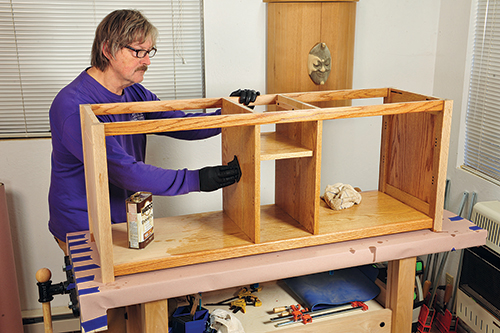
I do a lot of work with either knotty pine or red oak. Other than stains, can you give me some good tips on what to use for a final finish? I am now using about four coats of urethane. I often see you mention shellac, etc. Does shellac cause the pine to darken?
Ellis Walentine: First, to set the record straight, stains are not final finishes. They are used to color the wood prior to finishing. The final finish you use will vary depending on your finishing capabilities (e.g., do you have a spray gun), the environment the piece will reside in, and the type of abuse it will be exposed to.
If it’s an indoor piece that doesn’t get frequent or severe wear, you could get away with something as simple and easy as a Danish oil finish. For tabletops and surfaces that will be subjected to moisture or abrasion, I’d recommend a varnish–either a wiping varnish like Waterlox or a brushing varnish.
For wiping varnishes, figure three to five wiped coats followed by steel wool and wax. For a deeper finish and higher luster, keep going to ten coats or more. With brushing varnishes, such as McCloskey’s Heirloom, you can probably get away with three coats, sanded lightly with 220-grit Dri-Lube (or other stearated) sandpaper between coats. Personally, I stay away from waterborne coatings, because they look much colder and more artificial than oil-based varnishes.
If you have a spray outfit and want a film finish that protects the wood from moisture and abrasion, try spraying a catalyzed lacquer. The downside of this is that you may not be able to find it in the small quantities you need. You might be able to buy a couple quarts from a local cabinet shop.
Shellac has its pros and cons. If you use a dewaxed product, such as Zinsser Seal Coat, or you make it from scratch with flakes and alcohol, it will have enough moisture resistance to hold up well under normal use. I still don’t recommend it for tabletops. Shellac also handles, dries, and sands differently from the other options. Whichever finish you choose, you’ll need to experiment thoroughly with scrap wood before you finish the real thing.
Michael Dresdner: It is best to choose a finish not by the wood it goes on, but by the job it must do. Consider how durable it must be, what you want it to look like, and how you’d like to apply it. For instance, a bar top finish will have to be much tougher than one on a rarely handled picture frame.
As for the specific question about shellac: no, shellac does not cause pine to darken. Nor does it prevent pine from darkening. Sunlight causes pine to get darker, and will do so right through shellac, and most other clear finishes as well.





